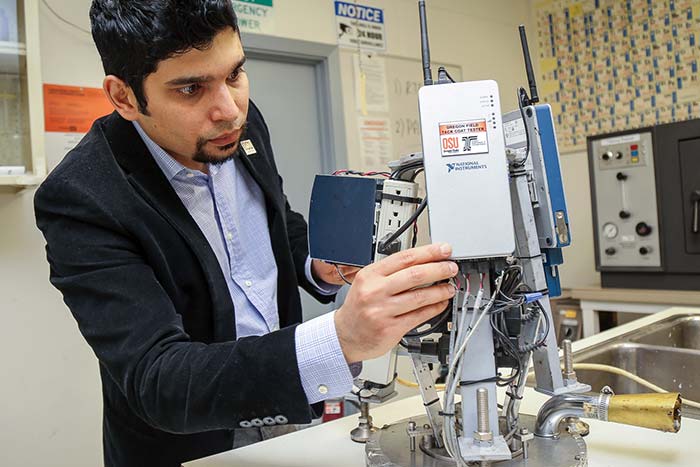Roadways are lifelines. They are more than the conduits we use to reach our next destination — roads connect people to economies, businesses, recreation, and life in modern society.
Although inflation has raised the cost of maintaining this vital infrastructure, funding levels for paving programs in Oregon, administered by the Oregon Department of Transportation, ODOT, have not kept pace. In fact, funding is about 30% lower than it was a decade ago. One impact of this shortfall is road resurfacing: Treatments typically last 10 to 20 years, yet current funding allows for new overlays every 30 years at most.
“There is a need to come up with new approaches — including different pavement construction methods incorporating recycled materials, innovative asphalt mix design procedures, and new technologies for quality control — to increase the longevity of pavement structures so we can keep the roadways in good, or even better, condition with limited funding,” said Erdem Coleri, assistant professor of infrastructure materials at Oregon State University.
One approach taken by Coleri and his research group in the Asphalt Materials Performance Laboratory is to examine the critical layer of adhesive applied between the layers of a road, known as tack coat. If the tack coat is not applied correctly during construction, major budget headaches can crop up. A road expected to last 20 years may last only seven.
To address this problem, Coleri and his team developed two field test devices, the Oregon Field Tack Coat Tester and the Oregon Field Torque Tester, which can be used to evaluate the long-term performance and bond strength of tack coats without the destructive removal of deep core samples from the pavement.
“If layers are not bonded properly, each layer acts independently and the overall structure is only as strong as the weakest layer,” said John Hickey, executive director of the Asphalt Pavement Association of Oregon, or APAO. “The work of Dr. Coleri and his team is guaranteed to result in better Oregon pavements.”
The APAO represents many ODOT contractors who apply tack coat in the field. The new test devices, completely designed at Oregon State — from hardware to software — will allow ODOT to inexpensively test the quality of tack coat bonds during road construction.
“The field test devices will be used for quality control and assurance, and basically ensure taxpayer funds are going to good use. Industry and ODOT do not want to see any pavements failing before reaching the end of their design lives,” Coleri said. “After the completion of the ongoing implementation research project, ODOT also intends to be the first transportation department in the U.S. to reward contractors who complete projects with a high bond strength.”
Coleri and his group are also making advances in reducing costs while improving performance at the beginning of the pavement life cycle, during the “recipe stage” known as asphalt mix design.
“We found that increasing the amount of recycled materials in the mix design from 20 to 40% decreases the cost by about 15%. In addition, according to our life cycle assessment, increasing the use of recycled materials significantly reduces levels of greenhouse gases produced in the manufacture of asphalt mix,” Coleri said.
Traditionally, the national standard for asphalt mix design favors strength to resist rutting. However, this can result in increased cracking, because stiffer materials break more easily than flexible materials. Coleri and his team are analyzing the formula currently used on Oregon highways to determine a more balanced mix that will resist cracking while retaining strength and rut resistance.
“If you put too much asphalt binder into your asphalt mix, you are going to have deformation,” Coleri said. “If you don’t put in enough, you are going to have cracking, so you need to balance the amount of binder. We are in the final phase of developing a balanced mix design method for ODOT, which is a new concept in pavement engineering.”
“I have been very pleased with the quality of research that has come from Dr. Coleri’s lab at Oregon State,” said ODOT pavement services engineer Justin G. Moderie, P.E., G.E., (’00 B.S. and ’02 M.S. Civil Engineering). “He has listened to the needs of ODOT and used that to further the effectiveness of his work toward more durable asphalt pavements and other projects.”
Working together, Oregon State, ODOT, and industry partners are reducing construction costs, improving road conditions, and maintaining the critical networks that sustain our daily lives.
Original post https://alertarticles.info
